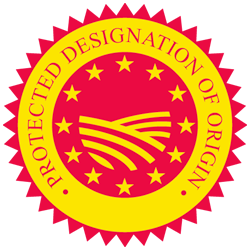La Morra, Monforte, Serralunga d’Alba (with its military fortress towering amidst the hills), Castiglione Falletto (the round towers belong to what is still a privately owned manor), Novello and Grinzane Cavour are all central municipalities of the Barolo area. Parts of Verduno, Diano d’Alba, Cherasco and Roddi (with its castle currently under restoration) are also included in the area.
The « king of wines, the wine of kings » emerged from the close ties between the intrinsic qualities of wine and noble 19th century tastes. It is full and intense ruby red in color, with an aroma that is both fruity and spicy. Its aroma and flavor carry notes which are redolent of small red fruits, cherries in spirit and preserve, along with hints of wilted rose and violet, cinnamon, pepper, nutmeg, vanilla and sometimes even liquorice, cocoa, tobacco and leather. It must age for at least 3 years, one and a half of which in oakwood, and at least 5 years to be labeled « Reserve ».
Already pleasant after 4-6 years, it culminates after 10 years of aging and remains excellent even after 20 or more years. Obviously this all depends on the vintage, which can be perfect or unlucky, as was notoriously the case in 1977, when the decision was made not to produce Barolo, or 2002, when rain and hail put serious pressure on the experience of wine makers.
There are numerous opportunities for savoring Barolo in its native land: the « Strada del Barolo » is a route lining several producers; Botteghe Comunali in Serralunga, Diano d’Alba, Castiglion Falletto; the Municipal Cellar of La Morra, the Grinzane Cavour Winehouse (with its central panorama of the area) and the Barolo Winehouse which will soon be home to a Wine Museum of immense value. Other locations, including private properties, are dotted throughout the Municipalities; vineyards are also increasingly welcoming visitors. This is why the Piemonte On Wine service has been created, described in the Local Networks chapter.


 En savoir plus
En savoir plus
 Lire moins
Lire moins










